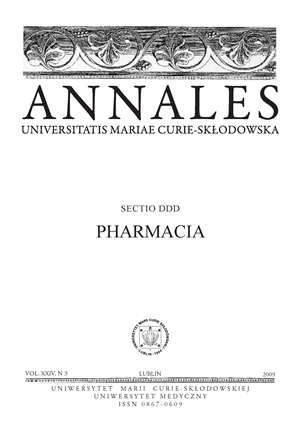Nowe aspekty indukowanej melatoniną obrony śluzówki jamy ustnejw trakcie doświadczalnego nadżerkowego zapalenia przełyku
Abstrakt
Badano zmiany morfologiczno-czynnościowe śluzówki jamy ustnej w przebiegu doświadczalnego nadżerkowego zapalenia przełyku, indukowanego w efekcie perfuzji kwasowo-pepsynowej modyfikacji aktywności PG/COX i po leczeniu melatoniną. Leczenie melatoniną zwiększało proliferację nabłonka i przyspieszało zdrowienie śluzówki. Melatonina wydaje się mediatorem procesów cytoprotekcyjnych śluzówki i zdrowienia wrzodów w efekcie zmniejszenia dysfunkcji nabłonka.
Bibliografia
1. Baatar D. et al.: Esophageal ulceration activates genes encoding keratinocyte growth factor and its receptor in rats: A key to esophageal ulcer healing? Gastroenterology, 122, 458, 2002.
2. Cutando A. et al.: Melatonin: potential functions in the oral cavity. J. Periodontol., 78(6), 1094, 2007.
3. Czesnikiewicz-Guzik M. et al.: Melatonin and its role in oxidative stress related diseases of oral cavity. JPP, 58 (3), 5, 2007.
4. Dean B. B. et al.: Night-time and daytime atypical manifestations of gastro-oesophageal reflux disease: frequency, severity and impact on health-related quality of life. Aliment. Pharmacol. Ther., 27(4), 327, 2008.
5. Konturek S. J. et al.: Role of melatonin in upper gastrointestinal tract. JPP, 58 (6), 23, 2007.
6. Nagy G.: Role of saliva, salivary glands and epidermal growth factor (EGF) on oral wound healing. Fogorv. Sz., 96, 1, 17, 2003.
7. Namiot Z. et al.: Modulatory effect of esophageal intraluminal mechanical and chemical stressors on salivary prostaglandin E2 in humans. Am. J. Med. Sci., 313(2), 90, 1997.
8. Oda Y. et al.: Accelerating effects of basic fibroblast growth factor on wound healing of rat palatal mucosa. J. Oral Maxil. Surg., 62, 1, 73, 2004.
9. Oginni A. O. et al.: The prevalence of dental erosion in Nigerian patients with gastrooesophageal reflux disease. BMC Oral Health, 92, 98, 2005.
10. Oh D. S. et al.: The impact of reflux composition on mucosal injury and esophageal function. J. Gastrointest. Surg. 10 (6), 787, 2006.
11. Shunji S.: Host defense of oral mucosa and the molecular mechanism of oral mucosal signal transduction diseases. J. Oral Biosci., 47 (2), 115, 2005.
12. Tarnawski A. et al.: Aging gastropathy – novel mechanisms: hypoxia, upregulation of multifunctional phosphatase PTEN and proapoptotic factors. Gastroenterology, 133(6), 1938, 2007.
13. Yaciv S. et al.: Multyfynkcionalna rol’ NO v stress-indukovanyh urajennyah slyzovoj yasen (experymental’ne modeluvannya). EPB, 1, 41, 2006.
14. Zayachkivska O. et al.: Protective influence of melatonin against acute esophageal lesions involves prostaglandins, nitric oxide and sensory nerves. JPP, 58(2), 361, 2007.
Pobrania
Opublikowane
Numer
Dział
Licencja
Prawa autorskie (c) 2009 Autorzy

Praca jest udostępniana na licencji Creative Commons Attribution-NonCommercial-NoDerivatives 3.0 Unported License.


